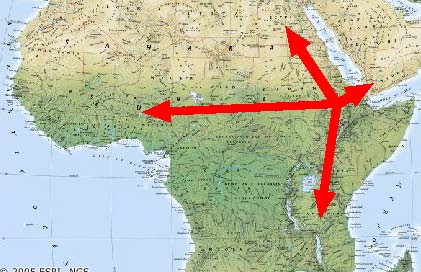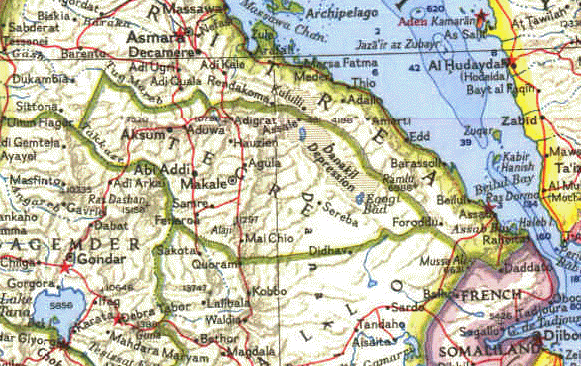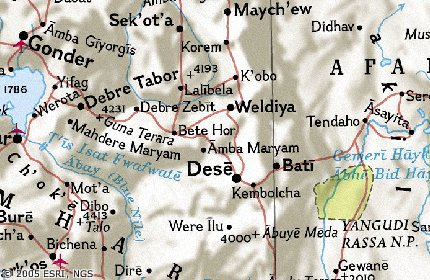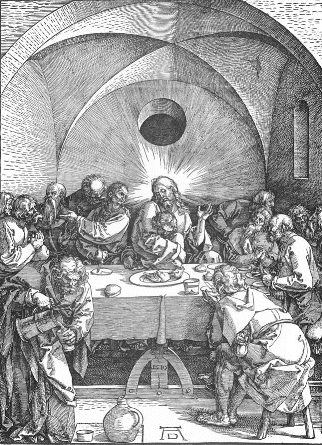
Here I use Africa to refer to Abyssinia, Eritrea, Ethiopia, Axum, Yemen, and other nations / cultures of the Nile / African Rift / Sahara-SubSahra region. Some, such as Yemen, may not even be on what is now conventionally defined as the continent of Africa, but my use is based on my cultural / historical perspective. Unless a more restricted meaning is clear from context, as used herein, any and all such terms are to be regarded as interchangeable synonyms for Africa.
According to a 21-27 August 2003 Al-Ahram article by Gamal Nkrumah:
"... It is in Ethiopia that the story of the evolution of mankind began. The remains of the earliest ancestral humans or hominids have been found there. ...Two Ethiopian regions stand out as preeminent sites favoured for habitation by the early hominids - the Omo Valley in the southwestern part of the country, and the Afar or Danakil Depression. To this day, these remote and inhospitable regions remain largely cut off from the outside world. They form different parts of Africa's Great Rift Valley,
/nilake.html
which runs from central Africa, through the eastern part of the continent, dissecting the Horn of Africa, dividing Arabia from Africa, marking out the outlines of the Sinai Peninsula, and ending somewhat unobtrusively with the Gulf of Aqaba and the River Jordan Valley.
- ... the Omo Valley is a veritable Garden of Eden with a rich and luxuriant tropical flora and teaming with exotic fauna.
- ... the Danakil Depression ... is a desolate and dreary desert, 100 metres below sea level and one of the hottest places on earth ...
Remains of Australopithecus Afarensis, an early hominid dating as far back as four million years, have been found in an almost complete state in the Danakil Depression, which was not always the arid desert it is today. When the early hominids roamed the Afar region, it was a well-watered and wooded savanna country. In 1974 archaeologists excavating sites in the Awash River Valley discovered the skeletal remains of a female hominid whom they promptly named "Lucy" ... three-and-half-feet tall Lucy ... lived some 3.5 million years ago. ...
... Ethiopians ... ( 6200-3000 BC ) ... began cultivating grains and crops ... The Early Bronze Age (3000 BC) witnessed the domestication of cattle ...
... The close proximity of the Ethiopian highlands to the Red Sea has always provided the main line of external communication.
[ Culture, trade, and genes spread from the Ethiopian highlands

South along the Rift Valley, West along the SubSharan Corridor, East across the Red Sea to Yemen and beyond, and North along the Nile Valley to the Mediterranean and beyond. (image adapted from National Geographic Atlas website) ]
... To ... Egyptians... Punt was the most ancient country, a sacred territory. Queen Hatshepsut in the 18th dynasty (1540-1304 BC) dispatched a diplomatic and trading mission to Punt ... Could ... Ethiopia be the Punt of the Egyptians? ... the sturdy tankwas, or papyrus canoes, that ply Lake Tana[ (image from National Geographic Maps CD-ROM)
According to a January 2004 solomonstemple.com web page article by Bob Cornuke:
"... Lake Tana, a body of water 53 miles long and 41 miles wide, [is] located on the headwaters of the Blue Nile. Isolated far out on the waters of Lake Tana is Tana Kirkos Island, considered by the Ethiopians to be a holy island, and populated only by Ethiopian Christian monks. The monks of Tana Kirkos believe they are living on the island where the Ark of the covenant rested, and where Levitical-style blood sacrifices were performed until 338 AD, when the nation of Ethiopia converted to Christianity ... the Ark itself was taken to Axum, where today it is kept in absolute isolation at St. Mary's of Zion Church. ...... the Ark ...[is]... a gold box with two winged creatures on the top ... 24 smaller angelic-type figures form ... a molding around the top, with two green stones ... at either end ...".]
- the source of the Blue Nile - are curiously reminiscent of the Ancient Egyptian reed boats. ...
... Axum...[was]... a prosperous state which at its zenith stretched from Nubia to Yemen and Hejaz, and encompassed much of the Horn of Africa ... The Axumite empire's heartland was the highlands of northern Ethiopia and southern Eritrea. ...
... The history of Ancient Ethiopia cannot be separated from that of Ancient Yemen, whose recorded history stretches back over 3,000 years. ...
... settled agricultural communities were established in the Yemeni highlands by the third millennium BC. Urban centres soon developed supported by the surrounding farming countryside. Masonry flourished and monumental sculptures and massive stone architecture were erected. Sophisticated irrigation works were also constructed which attest to a high degree of material sophistication. States like Hadhramaut, Saba, with it capital Ma'rib, and later Himyar thrived as industrious mercantile nations that monopolised the spice and incense trade of the ancient world.
Successive civilisations of Mineans, Sabaeans and Himyarites interacted closely with their counterparts in Ethiopia ... due to geographical proximity, strong cultural and trading links developed between the most celebrated of Ancient Yemeni civilisations, Saba, and the peoples of Ethiopia. ... Sheba, or the Kingdom of the South, could equally refer to either Yemen or Axum. ...
... In Yemen, the Minaean Civilisation was absorbed or superseded by the celebrated Sabaean Civilisation about 1000 BC. Trade relations were revolutionised when the inhabitants of Arabia domesticated the dromedary, or one-humped camel, in the 11th century BC. ...
... The Sabaeans united southern Arabia into a single political entity by the third century BC. By the time of the birth of Jesus Christ, they had expanded their empire to include Ethiopian lands across the Red Sea. With Sabaean power waning in the fifth and sixth centuries AD, their empire was conquered by the Ethiopians in 525. The Sabaean civilisation endured for 14 centuries lasting from around 800 BC to 600 AD. And as Saba declined, Axum arose. ... With the rise of Islam in the seventh century AD, Axum lost Yemen ... and the once flourishing empire shrunk back to its original core region of the northern Ethiopian highlands. ...".
According to a sacredsites.com web page:
"... Axum began to decline in the early decades of the 7th century following the rise and rapid expansion of the Muslim Arabs throughout the Middle East. Both Byzantium and the Persian Empire fell to the Arabs and this dealt a deathblow to the trading endeavors of the Axumite kings. Little is known of what became of the Axumite kingdom between the 8th and 11th centuries.Around the middle of the 11th century the Ethiopian state reappeared as the Christian Zagwe dynasty with its center in the town of Roha in the Amhara region of the Ethiopian highlands. The Zagwe dynasty, ruled over by eleven kings, lasted until the 13th century, when its last king abdicated in favor of a descendant of the old Axumite dynasty.
The most notable of the rulers of the Zagwe dynasty was King Lalibela who reigned from 1167 to 1207. ... According to legend, a dense cloud of bees surrounded the Prince Lalibela at the moment of his birth. His mother, claiming that the bees represented the soldiers who would one day serve her son, chose for him the name Lalibela, meaning "the bees recognize his sovereignty". ... The Ethiopian Orthodox church later canonized the King and changed the name of the city of Roha to Lalibela. ... A brilliant achievement of his reign was the construction of a dozen beautiful rock-hewn churches. ...
[ ]
... The churches of Lalibela are among the most extraordinary architectural creations of human civilization. Each church is sculpted, both inside and out, directly from the living bedrock of the earth (this type of architecture was not new to the area for there are numerous other examples around Ethiopia dating to earlier periods; the Zagwe constructions, however, took the art form to a new level). There are two basic types at Lalibela: rock-hewn cave churches which are cut inward from more or less vertical cliff faces and rock-hewn monolithic churches which imitate a built-up structure but are actually cut in one piece from the surrounding rock and separated from it by an encircling trench. ...".
According to a hope-of-israel web page by William F. Dankenbring and John D. Keyser:
"... the Jewish historian Josephus points out that ...[ Moses ]... had been a great general who led Pharaoh's army to victory over the kingdom of Ethiopia, which had conquered most of Egypt. While attacking the Ethiopian capital city, Tharbis, the daughter of the king of Ethiopia ... bargained to deliver the city into his hands if he would but marry her. ... Moses married her, and fulfilled the obligation of a husband to her, causing her to become pregnant (Josephus, Antiquities, II, x). This occurred sometime before 1532 B.C., when Moses was driven out of Egypt for slaying an Egyptian (Exodus 2: 11-150.....".
According to the King James Bible ( Numbers 12: 1, 3, 5, 6, 7, 8 and Deuteronomy 5: 1, 4, 5, 22 ):
"... Miriam and Aaron spake against Moses because of the Ethiopian woman whom he had married: for he had married an Ethiopian woman. ... the man Moses was very meek,
above all the men which were upon the face of the earth ... And the Lord came down in the pillar of the cloud, and ... said ... With ... My servant Moses ... will I speak mouth to mouth, even apparently, and not in dark speeches; and the similitude of the Lord shall he behold ...... And Moses called all Israel, and said unto them ... The Lord talked with you face to face in the mount out of the midst of the fire, ( I stood between the Lord and you at that time, to shew you the word of the Lord; for ye were afraid by reason of the fire, and went not up into the mount; ) ... These words the Lord spake ... And he wrote them in two tables of stone, and delivered them unto me. ...".
According to a 21-27 August 2003 Al-Ahram article by Gamal Nkrumah:
"... the Kebra Negast or Book of the Glory of Kings - from the Queen of Sheba to the rise of the Zagwe dynasty, is believed to be a 13th-century creation; its aim seems to have been to establish ... an Ethiopian king-list that traces the rulers of Ancient Axum to Menelik I (originally Bin Ha Malik, The King's Son), the son of the "Israelite" King Solomon and the "Ethiopian" Queen Makeda, the Queen of Sheba ... historians suggest that King Solomon must have reigned around the 10th century BC. ...".
According to the Kbre Nege'st in the book "The Kebra Nagast" edited by Gerald Hausman ( St. Martin's Press, New York1997 ):
"... Solomon [said] ... to the Queen [of Sheba]: ... I saw many visions in a dream. The sun rose on Israel, but it went away and lighted up the country of Ethiopia. So that country shall be blessed through you. ... Nine months aand five days ...[later]... the Queen ... brought forth a man-child [Solomon's firstborn] ... and she called him Bayna-Lehkem. ...[when]... he was twenty-two years old ... Bayna-Lehkem came through ...[the]... gate ... [of his father King Solomon]... when King Solomon sw his son he ... said, "Behold my father David has renewed his youth and has risen from the dead." Then he said to all of his court, "... He is David ...".... Gabriel ... the Angel of Death ... said to ... Solomon ... "... Harken to what I say, for God has sent me. From being a wise man you have turned into a fool ... and all because you have broken the commandment of God. You held this lightly, thinking you were wiser than God and believing you would have many male children. Know that your Salvation was created in the belly of Adam. And it began in the form of a pearl before Eve. The pearl ... went forth from the belly of Adam into the belly of Seth. And then it ... came to Arbam. And it .. went into Isaac the pure ... into Jacob the humble ... into Judh, the innocent ... And ... it came to Fares the patient. And from him the pearl went to the firstborn until it came into the belly of Jesse, your grandfather. And then ... it went to the seventh, David, your innocent and humble father. Now the pearl of your salvation will pass through many generations until it will reach him who ... is crucified without sin and who rises without corruption. He who goes into Sheol and tears down its walls. ...
... the pearl shall be carried in the belly of Rehoboam your [second-born] son, and shall be the savior of all the world. ...
My opinion is that Mary Magdalene was from

the town of Magdala in Ethiopia (map from National Geographic Maps CD, Africa: Countries of the Nile, October 1963). As shown by a later map (from National Geographic Atlas web site)

the town known as Madgala during the time of Jesus is now known as Amba Maryam. Although it is commonly thought that Ethiopian references to Mary refer to Mary the Mother of Jesus, I speculate that the Mary of Amba Maryam refers to Mary Magdalene, the Mary from the town formerly known as Magdala.
This Durer woodcut The Large Passion - 9 of 12 - Last Supper - 1510

showing 6 apostles on each side of the couple Jesus and Mary Magdalene indicates that in Durer's Europe ca 1500 it was believed (at least by some) that Jesus and Mary Magdalene were man and wife, with Mary Madgalene being even closer to Jesus than the 12 apostles.
According to a book "Bloodline of the Holy Grail" by Laurence Gardner on a karenlyster web page and related pages:
"... Dynastic heirs such as Jesus were expressly required to perpetuate their lines. Marriage was essential, but community law protected the dynasts against marriage to women who proved barren or kept miscarrying. This protection was provided by the three-month pregnancy rule. Miscarriages would not often happen after that term, subsequent to which it was considered safe enough to complete the marriage contract. ..... There are seven lists given in the Gospels of the women who were Jesus's regular companions. These lists all include his mother, but in six of these seven lists the first name given (even ahead of Jesus's mother) is that of Mary Magdalene, making it plain that she was, in fact, the First Lady: the Messianic Queen. ...
Of all the four Gospels, only John records the wedding feast at Cana ...[which]... can be dated to the summer of AD 30, in the month equivalent to our modern June. ... the Cana ceremony ... appears to have been their own betrothal feast ...[It]... embodie[d] the ... water and wine ... wine taken at betrothal feasts was only available to priests and celibate Jews, not to married men, novices or any others who were regarded as being unsanctified. They were allowed only water ... Mary ... and Jesus then flouted convention, abandoning the water to provide wine for everyone. ...
... The first (the anointing in Luke) ... was the legal commitment to wedlock ... First weddings were always held in the month of Atonement (modern September) and betrothal feasts were held three months before that. In this particular instance, we find that the first marital anointing of Jesus by Mary Magdalene was at the Atonement of AD 30, three months after the Cana ceremony ...
... the second (the later anointing in Matthew, Mark and John) was the cementing of the contract. ... the ... anointings of Jesus by Mary at Bethany. ... From that day she would carry a vial of spikenard around her neck, throughout her husband's life, to be used again on his entombment. It was for this very purpose that Mary Magdalene would have gone to Jesus's tomb, as she did on the Sabbath after the Crucifixion. .... In Jesus and Mary's case the second anointing was of particular significance for, as explained by Flavius Josephus in the 1st-century Antiquities of the Jews, the second part of the marriage ceremony was never conducted until the wife was three months pregnant. ... the trial and crucifixion of Jesus are mentioned in the Annals of Imperial Rome. We can now determine from chronological survey that the Crucifixion took place at the March Passover of AD 33, while the Bethany second marriage anointing was in the week prior to that. We also know that, at that stage, Mary Magdalene had to have been three months pregnant - which means she should have given birth in September of AD 33. ...".
According to the Acts of Yesu ("... Acts of Yesu became public in the Europe as the apocryphal book that Fr. Martin Corzeni, who worked in the Vatican archives for years, secretly removed from the library. After his terrible death in 1982, Acts of Yesu was discovered (by his landlord) among his possessions in a room where he sometimes boarded. He died from inhalation of a nerve toxin. ... The copy of Acts of Yesu available here is not the original that Fr. Corzeni brought into the light. This is an English translation of the original text, discovered in North western Pakistan in 1999. Translation was made by a female monk who specialize in ancient Persian language. What is remarkable is the slight differences between the English text in use by some groups and the ancient Corzeni copy in the original text. ...".):
"... When the time came for the Lord to finish the ministry in body he was 34 years old and accomplished in spirit to the Saviour, and he commanded many to teach the mysteries of the baptisms to worthy ones. ...... Yesu the Lord prepared for seven days and went up to give himself to the evil ones of the pious of those lands to hang him up as despicable, for that is what the world does with holiness, unto to the death of the body; because he was to discard it for the sake of the ministry in the other universes; and he left the body to die and he gained union with God as the beloved son. ...
... after three days he removed that dead body from its filthy grave and swaddling clothes and made it alive again when he needed it. And the Lord travelled the lands of his former ministries, appearing whenever he needed; and he brought with him a great army of angels to light the Way.
And the Lord appeared first to Mari his beloved companion and to his blessed mother and the devotees (apostles) of that land, that they too may believe; and he sent the devotees to minister in different lands and appeared to be with them. And the Lord ministered to the congregations of Yuda in Kushan, and James in Egypt and Mari in Alexandria, in Ethiopia, Peter in Armenia, in Syria, with Matthew in Parthia and Yuda when he became the Thoma in India for many years. ...".
According to a valdosta.edu web page:
"... [A] Project Change ... anti-racism initiative ...[helped to enable]... an Unknown Slaves Monument in Sunset Hills Cemetery [in Valdosta, Georgia USA]....".
......